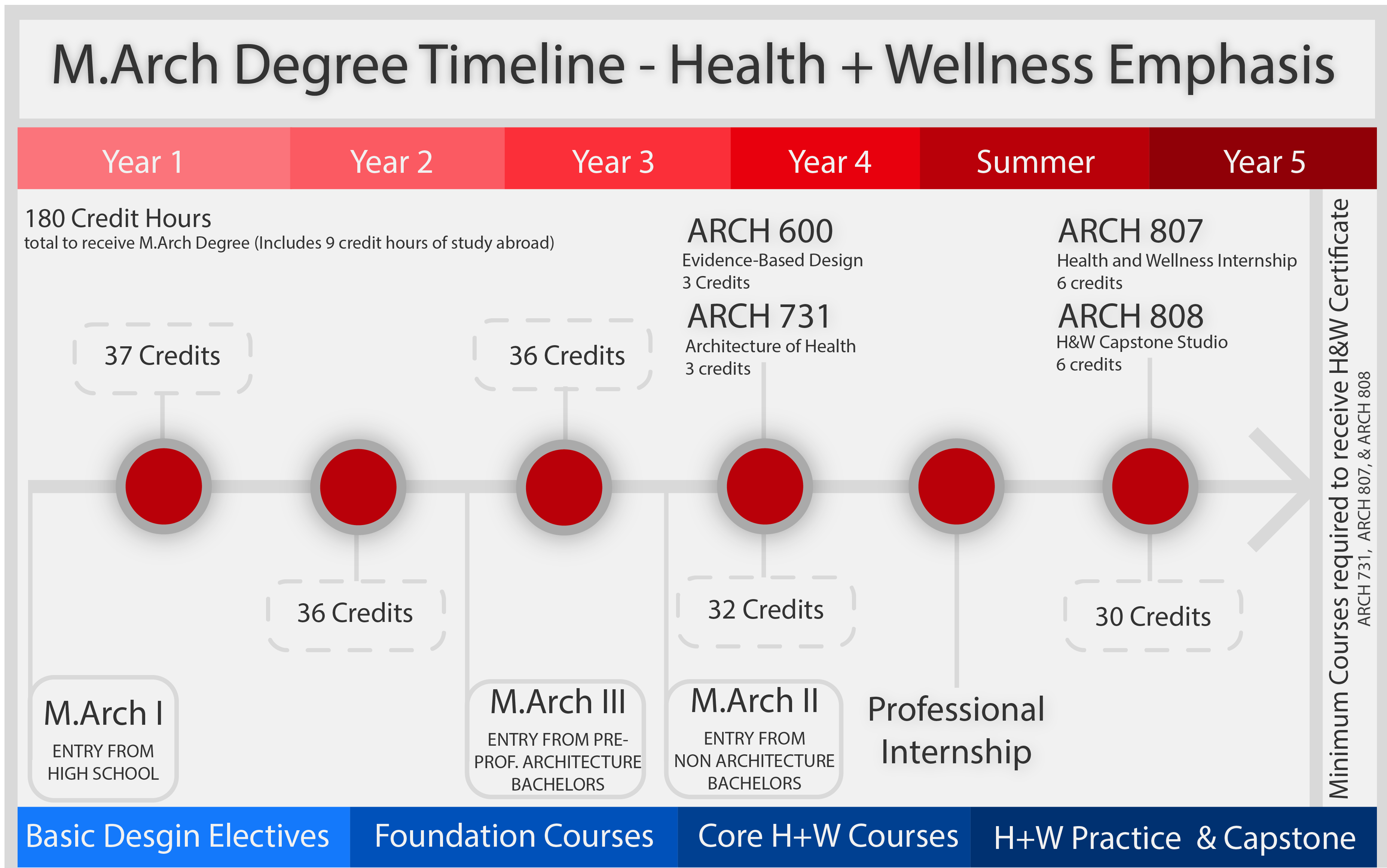
Curriculum
Students may enter the Health & Wellness option in their fourth year of the Master of Architecture (M.Arch. I) program. For students entering KU with a four-year pre-professional degree in architecture, they would apply to the M.Arch. II degree program and complete a two-year course of study in the Health & Wellness curriculum. M.Arch. I is a 180-credit hour program and M.Arch. II is a 75-credit hour program. See a diagram of the KU M.Arch program with an emphasis on Health + Wellness.
All of the students in their final year of the KU Master of Architecture (M.Arch) program choose an option to concentrate and focus their studies. The Health & Wellness option allows the student in-depth study in this area through a series of seminars, professional internships, and a capstone studio.
Core Health + Wellness M.Arch Courses:
- ARCH 731: Architecture of Health (3 credit hours): An introduction to healthcare facilities and systems which is usually taken in the spring semester.
- ARCH 807: Health & Wellness Internship (6 credit hours): A seven-month paid internship in a professional firm doing significant design, planning and/or research in environments that contribute to human health and well-being.
- ARCH 808: Health & Wellness Capstone Studio (6 credit hours): The final studio for graduates in the M.Arch. curriculum allows the student to integrate all aspects of their previous coursework, internship experience, and professional interests.
Students who complete the required course sequence in this curriculum are eligible to receive the Graduate Certificate in Architecture of Health & Wellness. Please refer to the Health & Wellness Certificate page for details.
Students entering the Master of Architecture program from high school (M.Arch. I) will begin taking Health & Wellness elective courses in their third year and will enter the Health & Wellness option in Year 4.
Students who enter the Master of Architecture program with a pre-professional architecture degree from another university are admitted to the two-year M.Arch. II program and begin the Health & Wellness program in Year 4 of the architectural curriculum. See below a diagram below the timeline of the KU M.Arch program with an emphasis on Health & Wellness.

Growing evidence has demonstrated strong links between the built environment and human health and wellness. The Health & Wellness program at the school of Architecture & Design at the University of Kansas, including both the professional program and the PhD concentration, is one of the strongest programs in the nation that is dedicated to research and design education about environments for health and wellness. It is built on close collaborations between an interdisciplinary team of faculty, affiliated professionals, and several academic and research programs (including the KU Medical Center, the KU School of Medicine and School of Nursing, the KU Life Span Institute, the KU Civil, Environmental and Architectural Engineering at School of Engineering, and the KU Center for Sustainability.
The goal of the PhD in Health & Wellness concentration is to use evidence-based design approaches to study the impacts of design on human health and wellness. The scope varies at multiple scales, from object, to room, to building and site, to entire communities. This concentration provides students with the theoretical, technical and applied knowledge and skills to prepare them for academic and professional careers to promote human wellness in a variety of building types (e.g. healthcare, senior care, office, education, recreation).
The PhD curriculum in H&W focuses on developing skills in quantitative and qualitative research on health-related design. In addition, H&W PhD students may also consider participating in the seven-month health and wellness professional internship, which is currently offered in the professional program.
Some topics that students may investigate in this program are:
- Inpatient and ambulatory healthcare facilities
- Environments for special populations
- Natural or built environments that enhance human wellness
- Environments that support healthy and productive workplaces
- Neighborhoods that improve the physical, social and cultural health of the community
Recommended Health & Wellness courses include:
Core Health & Wellness PhD Courses:
- ARCH 600: Evidence-based Design in Healthcare Facilities
- ARCH 731: Architecture of Health
Other Health & Wellness courses offered to PhD students:
- ARCH 807: Healthy and Sustainable Environments Internship
- ARCH 692: Documentation (in conjunction with ARCH 807)
- ARCH 808: Healthy and Sustainable Environments Capstone Studio

More information in the KU PhD in architecture page and the MA/PhD Student’s Handbook (pdf).